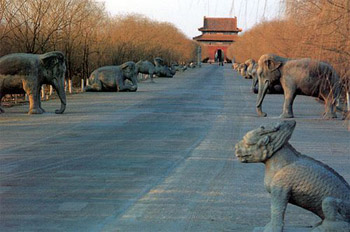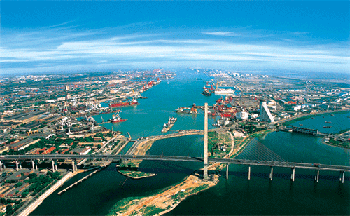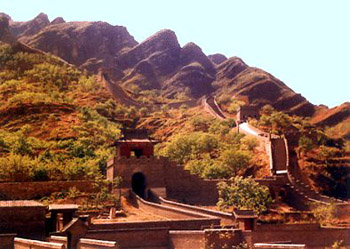search for a Trip
The introduction of Tianjin
Tianjin, also known as the diamond of the Bohai Gulf and the gateway to the capital of the People's Republic of China, is one of the biggest industrial and port cities in China. The city has a long and illustrious history, and the marks that the past has imprinted upon the place can still be seen today, albeit in diminished.
For the visitor today, this legacy can still be glimpsed, in the varied and beautiful architecture of the old concessionary areas, amongst the foibles and antiques to be found in the winding streets of the antique market, and with visits to the profusion of religious buildings that litter the city.
Main attractions in Tianjin
Great Wall at Huangya Pass
 The Great Wall at Huangyaguan (Huangyaguan changcheng) geographically belongs to Ji County at the very northern tip of the Tianjin Municipality and is some 28km north of Jixian County Town. The pass, the only one of its kind in Ji County, contains the section of the the Great Wall that extends northward to Hebei Province. During the sunset, the pass looks even more imposing with the steep slopes on both sides. Even during the Qing Dynasty over two thousand ago, it was an important pass in northern China. In recent years, some new features have been added to the original construction, such as the Eight Diagrams Labyrinth (Bagua cheng), the Forest of Steles (Shike beilin), a museum (Bowuguan) and the Water Pass (Shui guan). The wall here has also been renovated recently, although its edges still show signs of decaying age. The most redeeming factor of this section is that it is less plagued by tourists than its Beijing counterparts.
The Great Wall at Huangyaguan (Huangyaguan changcheng) geographically belongs to Ji County at the very northern tip of the Tianjin Municipality and is some 28km north of Jixian County Town. The pass, the only one of its kind in Ji County, contains the section of the the Great Wall that extends northward to Hebei Province. During the sunset, the pass looks even more imposing with the steep slopes on both sides. Even during the Qing Dynasty over two thousand ago, it was an important pass in northern China. In recent years, some new features have been added to the original construction, such as the Eight Diagrams Labyrinth (Bagua cheng), the Forest of Steles (Shike beilin), a museum (Bowuguan) and the Water Pass (Shui guan). The wall here has also been renovated recently, although its edges still show signs of decaying age. The most redeeming factor of this section is that it is less plagued by tourists than its Beijing counterparts.
Eastern Qing Mausoleum
 Eastern Qing Mausoleums, located 125 kilometers northwest of Beijing, are among the finest and largest extant Mausoleum complexes in China. Like the Western Qing Mausoleums are the sacred burial grounds of Qing emperors, empresses and imperial concubines. Situated to the west of Malanyu Village in Zunhua County, Hebei Province, the entire complex covers an area of 2,500 square kilometers. The construction of the tombs was begun in the second year of the reign of Emperor Kangxi (1663). The main Mausoleums include those of the following emperors, here listed with their reign periods: Shunzhi (1644-1661), Kangxi (1662-1722), Qianlong (1736-1796), Xianfeng (1851-1861), Tongzhi (1862-1875), and Empress Dowager Cixi (died 1908). In addition, four Mausoleums containing the remains of 136 imperial concubines and one Mausoleum for princesses are also located here.
Eastern Qing Mausoleums, located 125 kilometers northwest of Beijing, are among the finest and largest extant Mausoleum complexes in China. Like the Western Qing Mausoleums are the sacred burial grounds of Qing emperors, empresses and imperial concubines. Situated to the west of Malanyu Village in Zunhua County, Hebei Province, the entire complex covers an area of 2,500 square kilometers. The construction of the tombs was begun in the second year of the reign of Emperor Kangxi (1663). The main Mausoleums include those of the following emperors, here listed with their reign periods: Shunzhi (1644-1661), Kangxi (1662-1722), Qianlong (1736-1796), Xianfeng (1851-1861), Tongzhi (1862-1875), and Empress Dowager Cixi (died 1908). In addition, four Mausoleums containing the remains of 136 imperial concubines and one Mausoleum for princesses are also located here.
Climate in Tianjin
 Tianjin falls within the temperate zone, and, being a port city in northern China, it is frequently affected by tidal air currents. The annual average temperature here is about 13 degrees C. July is the hottest month, with the temperature above 26 degrees C., while January is the coldest, when below freezing temperatures can be expected.
Tianjin falls within the temperate zone, and, being a port city in northern China, it is frequently affected by tidal air currents. The annual average temperature here is about 13 degrees C. July is the hottest month, with the temperature above 26 degrees C., while January is the coldest, when below freezing temperatures can be expected.
|
Month |
Jan |
Feb |
Mar |
Apr |
May |
Jun |
Jul |
Aug |
Sep |
Oct |
Nov |
Dec |
|
Temperature (Celsius) |
-4.6 |
-2.2 |
4.5 |
13.1 |
19.8 |
24.0 |
25.8 |
24.4 |
19.4 |
12.4 |
4.1 |
-2.7 |
China Attractions Guide
- Anhui Attractions
- Beijing Attractions
- Chongqing Attractions
- Fujian Attractions
- Gansu Attractions
- Guangdong Attractions
- Guangxi Attractions
- Guizhou Attractions
- Hainan Attractions
- Henan Attractions
- Hongkong Attractions
- Hubei Attractions
- Hunan Attractions
- Inner Mongolia Attractions
- Jiangsu Attractions
- Jiangxi Attractions
- Manchuria Attractions
- Ningxia Attractions
- Qinghai Attractions
- Shaanxi Attractions


